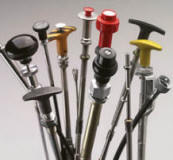|
This implementation case study is a real company with real people. For
confidentiality, we will call it "Mechtrol", though that is not their name. When Mechtrol was
founded twenty or thirty years before, it was highly successful and made large volume orders
with limited variety.
Over the years, markets changed and the product mix became increasingly varied and
with much smaller orders. The increasing variety demanded increasing overhead in terms of
engineering, material handlers, salespeople, production control, and a host of other tasks.
The traditional accounting allocations tended to assign too much overhead cost to
high volume products and not enough to low volume. This had, in turn, led to more low-volume
orders and fewer high-volume orders. But these effects were so slow in developing that they went
unnoticed.
|
 Now, Mechtrol was in trouble. Profit
margins were low and market share declining. Quality and delivery was not competitive. Two or
three consultants spent the better part of four months at the firm. They taught, learned,
experimented, and cajoled. As always, paradigm changes are difficult and frustrating and
Mechtrol was no exception. Now, Mechtrol was in trouble. Profit
margins were low and market share declining. Quality and delivery was not competitive. Two or
three consultants spent the better part of four months at the firm. They taught, learned,
experimented, and cajoled. As always, paradigm changes are difficult and frustrating and
Mechtrol was no exception.
In the end, five workcells were in place
and a macro layout showed the locations of remaining cells. Training was well along and teams
were developing. Supervisors were learning to deal with the cell environment. Mechtrol carried
on this work in the years that followed. The organization had internalized the lessons and
spirit of Lean Manufacturing.
|
Summary
| Element |
Original
Situation |
Changes |
|
Workcells & Flow Layout |
Products were built on long, high-speed assembly lines. Separate sub-assembly areas built
up orders of subassemblies prior to running the order on the line. |
We
identified product families based on commonality of parts and tooling. Cells were then designed
each capable of operating with 1-10 workers. Almost all operations, including subassembly,
are now internal to the cells. |
|
Teams |
An
informal social hierarchy existed in the factory that was largely based on skills and job
classification. At the very top were Tool & Die Makers. Then came Screw-Machine Operators, Punch
Press Operators, Setup Men, Machine Operators, and Assemblers in that order. The social
structure was dysfunctional and caused large inefficiencies for a variety of reasons. |
Teams were formed for each workcell. They had training in SPC and problem-solving but not in
team processes. Nevertheless, because of the cell design, the teams quickly bonded and
generally work well together. Teams perform setups, Quality Assurance, and Packaging which
had previously been in a different department. |
|
Lean Scheduling |
Scheduling was done on an MRP system that was so old there was no longer software support.
Moreover, the system was not trusted due to a lack of data integrity and general performance. |
Initially, the MRP system was simply bypassed. Kanban stockpoints were set up for repetitive
components. Some repetitive end-products used a Kanban stockpoint in Finished Goods. Low
volume or intermittent products were built to order. Several years later, the MRP system was
replaced. Because Mechtrol now had the experience to know what was needed, the new MRP was very
successful. |
|
Rapid Setup |
Setup
operations were casual. Many small presses and machines had to be setup and then all of them
arranged along the assembly line before starting a run. A major line changeover could take
all day. To minimize major changeovers, orders were grouped by similarity and had to be run
in sequence. This complicated scheduling, created WIP, excess finished goods and introduced
wide variability into the lead time. |
1)
The workcell configuration limits the number of different fixtures within a cell and thus
reduces the number of setups.
2) The firm's Tool & Die shop consolidated multiple operations onto a single die-set for some
products. Other modifications speed setups.
3) Cell workers perform setup operations and have incentives to setup fast. |
|
Six Sigma |
Quality consisted of a final inspection at the end of each high-speed line. By the time
defects were caught, all of the subassembly work was complete and many items were in final
assembly. Moreover, there were upwards of 20 people working on the line and stopping it to
fix the quality problems was disastrous for productivity. |
Cell teams inspect their own work after training in blueprint reading, SPC, and measurement.
Former inspectors audit quality occasionally, setup SPC charts, and monitor SPC activities.
In the first cell, quality improved by more than 90% within the first few days. |
|
5-S |
The plant was a mess. WIP and tooling was scattered everywhere. Aisles were crooked and
often blocked. |
Following the initial re-arrangements, the firm spent many years organizing work at the
detail level. The disappearance of WIP freed space. Floors are painted, teams clean
their areas every day. This factory looks and feels World-Class. |
|



